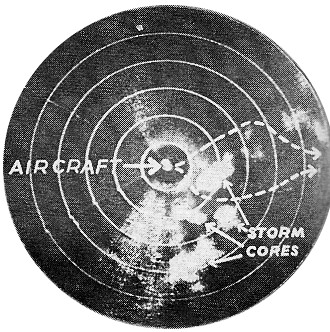|
RCA (Radio
Corporation of America) is not really the first company name that comes to mind
when thinking about radar, be it weather, aircraft navigation, or nautical
navigation. Instead, I think of radios and televisions and even satellites; RCA
developed the circa 1958
SCORE (Signal Communication by Orbiting Relay Equipment) series. According
to this 1955 article in Radio & Television News magazine, RCA designed
and built a a C-band airborne radar system for detecting adverse weather
conditions enroute, at a range of up to 150 miles. Operating at around 5.4 GHz
(modern weather radars prefer X-band) at 75 kW peak, the
AVQ-10 radar unit was primarily meant for weather avoidance rather than for
terrain and aircraft avoidance. The installed weight of 125 pounds was rather
amazing considering the use of vacuum tubes and a CRT display (also a vacuum
tube), along with leaded passive components and bulky, heavy (relatively)
transformers for providing high voltages. BTW, the standard aircraft AC power
supply frequency of 400 Hz rather than land-based systems at 50 Hz and 60 Hz
facilitated the use of smaller transformers and capacitors when converting to DC
and filtering.
Weather Detection Radar
 United Air Lines is currently installing
RCA's new C-band radar units in its fleet. Pilots can determine possible corridors
through storm areas for smoother flights. United Air Lines is currently installing
RCA's new C-band radar units in its fleet. Pilots can determine possible corridors
through storm areas for smoother flights.
RCA's new, compact, 125 lb. airborne radar set provides increased passenger comfort.
A new and unique airborne radar unit especially designed by RCA for commercial
and executive planes is now being installed in United Air Lines' entire fleet.

Example airborne weather radar display.

L. E. Sebald of United Airlines (UAL) demonstrates antenna of C-band radar installed on "Mainliner
O'Connor." Nose of Convair 340 has been extended 28 1/2" to house antenna and gear
unit."
Use of the new C-band (5.5 cm.) radar enables pilots to determine corridors for
smooth flight through storms which appear solid to the unaided eye. Excessive turbulence
can thus be bypassed, resulting in greater passenger comfort. Schedule regularity
will also benefit since time-consuming detours around storms no longer will be required.
The new AVQ-10 radar unit is designed primarily for weather detection rather
than for terrain mapping or the detection and avoidance of aircraft. Its terrain
mapping ability, however, is sufficiently good to identify deep river beds, large
lakes mountain ridges, peaks, and other surface features.
The indicator is a 13-pound shock-mounted unit with a 5" viewing screen.
It produces a 360 degree continuously rotating PPI-type presentation giving an
effective forward "looking" sector of approximately 270 degrees. This sector will
vary slightly with the plane.
Four controls are provided on the face of the indicator. One of three ranges
may also be selected, 25, 50, or 150 nautical miles.
The control panel, a small inconspicuous unit, provides for selection of all
the necessary radar functions with a minimum of controls. It is designed for plug-in
installation. The balance of the equipment (transmitter-receiver accessory unit,
and antenna gear mechanism) can all be housed outside the cockpit if desired.
Posted October 21, 2020
|












